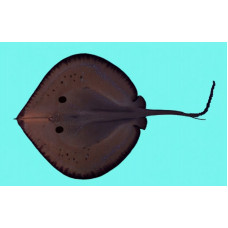Latin name
Plesiobatis daviesi
Other name
Giant stingaree
Identification
The body of the deepwater stingray is flabby, with the pectoral fins forming a rounded disc that is longer than it is wide. The front edge of the body forms a blunt angle. The snout is slender, 6 times longer than the diameter of the eyeball, with the tip projecting slightly beyond the edge of the disc. Behind the small eyes are spiracles with a pointed back margin. The large rounded nostrils are next to the mouth, to which they are connected by a pair of broad furrows. Between the nostrils is a wide flap of skin with a strongly wrinkled edge. The wide, straight mouth contains 32-60 rows of teeth on each jaw. Adults have more teeth. Each tooth ends in a low, blunt point; in adult males, the central teeth are sharper and slant backwards. The underside of the disc has five gill slits on each side. The skin is densely covered with scales.
Features of fish fins
Dorsal spines (total): 0.
The pelvic fins of these rays are small, with rounded outer edges. The length of the rather thick tail is 93-102% of the length of the operculum. Lateral skin folds on the tail and dorsal fins are absent. There are one or two serrated spines on the dorsal surface in the middle part of the tail. Behind this is a long, slender, leaf-shaped caudal fin, the upper and lower lobes of which are almost symmetrical. Scales are absent or sparsely scattered on the pelvic fins, on the ventral surface of the disc margins and around the mouth.
Fish colouring
The colouration of the dorsal surface of the deepwater stingray is scarlet brown to blackish, some individuals have dark spots and irregularly shaped markings. The ventral side is white with a dark band along the edge of the disc. The underside of the caudal peduncle and caudal fin are dark.
Distribution
Deep-sea stingrays are found in the Indo-Pacific off KwaZulu-Natal, South Africa, Mozambique, the Gulf of Manar, the northern Andaman Islands, the South China Sea, the Ryukyu Islands, along the southern coast of Australia, in north-west Australian waters from Rowley Reefs to Shark Bay, off the north-east coast of Australia from Townsville to Woolley, off New Caledonia and Hawaii.
Habitat
This species is found on the slope of the mainland at depths between 275 and 680 metres and prefers muddy bottoms. There are anecdotal reports of these rays being caught off the coast of Mozambique at an anomalous depth of 44 metres. They are quite common in tropical Asian waters, but less so elsewhere.
Size
The maximum recorded length of individuals of this species is 2.7 m, width 1.5 m and weight 118 kg.
Behavior
The deepwater stingray has a long spike that can deliver a painful blow if touched.
Food and feeding habits
The diet of the deepwater stingray consists of cephalopods, crustaceans (shrimps, crabs and lobsters) and bony fish. The long and flexible snout is well adapted to digging in the sediment, while the presence of mesopelagic animals in the diet suggests that these rays can hunt beyond the bottom.
Reproduction
Fish of this species reproduce by live birth, with embryos feeding on egg yolk and histotrophs. Given its large size and deep-sea habitat, it is a slow-breeding ray with few litters and a long gestation period. Newborn rays are about 50 cm long. Juvenile rays of about this length have been seen with remnants of the yolk sac scar. Males and females reach sexual maturity at lengths of 1.3-1.7 m and 1.9-2 m respectively.
Fishing
This fish is not of interest for commercial fishing. They are not intensively fished throughout their range and are only caught in small numbers as by-catch.
Relationship with a person
Venomous. The meat of these stingrays is edible but not highly prized.
| Classification | |
| Phylum | Chordata |
| Class | Chondrichthyes |
| Squad | Myliobatiformes |
| Family | Plesiobatidae |
| Genus | Plesiobatis |
| Species | P. daviesi |
| Features | |
| Conservation status | Least Concern |
| Habitat | Pelagic |
| Life span, years | No information |
| Maximum body weight, kg | 118 |
| Maximum length, cm | 270 |
| Sailing speed, m/s | No information |
| Threat to people | Edible |
| Way of eating | Planktonophage |
Deepwater stingray
Tags: deepwater stingray

